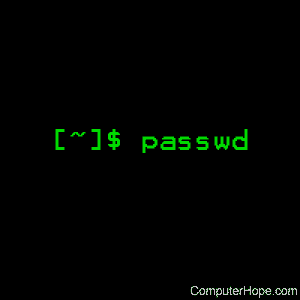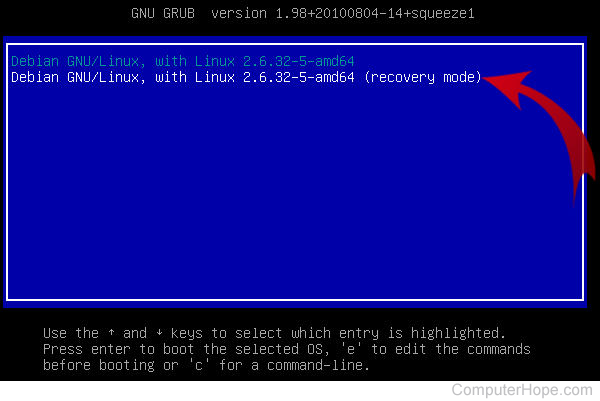Linux passwd command

About passwd
On Unix-like operating systems, the passwd command is used to change the password of a user account. A normal user can run passwd to change their password, and a system administrator (the superuser) can use passwd to change another user's password, or define how that account's password can be used or changed.
This page covers the Linux version of passwd.
Description
The passwd command changes passwords for user accounts. A normal user can only change the password for their account, but the superuser can change the password for any account. passwd can also change or reset the account's validity period — how much time can pass before the password expires and must be changed.
Before a normal user can change their password, they must first enter their current password for verification. (The superuser can bypass this step when changing another user's password.)
After the current password is verified, passwd checks to see if the user is allowed to change their password at this time. If not, passwd refuses to continue, and exits.
Otherwise, the user is then prompted twice for a replacement password. Both entries must match for passwd to continue.
Next, the password is tested for complexity. As a general guideline, passwords should consist of at least 6 characters, including one or more of each of the following:
- lower case letters
- digits 0 through 9
- punctuation marks
Syntax
passwd [OPTION] [USER]
Options
The following options change the way passwd operates:
| -a, --all | When used with -S (see below), this option shows the password status for all users. This option won't work if used without -S. |
| -d, --delete | Delete a user's password (make it empty). This option is a quick way to disable logins for an account, without disabling the account itself. |
| -e, --expire | Immediately expire an account's password. This forces a user to change their password the next time they log in. |
| -h, --help | Display information about how to use the passwd command. |
| -i, --inactive INACTIVE |
This option is used to disable an account after the password was expired for many days. After a user account has had an expired password for integer INACTIVE days, the user may no longer sign on to the account. |
| -k, --keep-tokens | Keep password tokens. Indicates that this user's password should only be changed if it has expired. |
| -l, --lock | Lock the password of the named account. This option disables a password by changing it to a value which matches no possible encrypted value. It does this by adding a character at the beginning of the encrypted password. Note that this does not disable the account. The user may still be able to log in using another authentication method (an SSH key, for example). To disable the account, the superuser can use the usermod command with the option --expiredate 1. This option sets the account's expiration date to a date in the past — namely Jan 2, 1970. Users with a locked password are not allowed to change their password. |
| -n, --mindays MIN_DAYS |
Set the minimum number of days between password changes to MIN_DAYS. A value of zero for this field indicates that the user may change his/her password at any time. |
| -q, --quiet | Quiet mode; passwd will operate without displaying any output. |
| -R, --root CHROOT_DIR |
For advanced users: this option applies changes in the chroot directory CHROOT_DIR and use the configuration files from the CHROOT_DIR directory. |
| -S, --status | Display account status information. The status information consists of 7 fields:
In fields 4 through 7, password ages are expressed in days. Specifying -a in addition to -S displays password status for all users. |
| -u, --unlock | Unlock the password of the named account. This option re-enables a password by changing the password back to its value before the -l option was used to lock it. |
| -w, --warndays WARN_DAYS |
Set the number of days of warning before a password change is required. WARN_DAYS is the number of days before the password expiring that a user will be warned that their password is about to expire. |
| -x, --maxdays MAX_DAYS |
Set the maximum number of days a password remains valid. After MAX_DAYS, the password must be changed. |
Notes
Password complexity varies depending on the system. Consult your operating system documentation for default complexity rules and how to change them.
On systems that use NIS (Network Information Services), users may not be able to change their password if they are not logged in to the NIS server.
Files used by passwd
| /etc/passwd | User account information. |
| /etc/shadow | Secure user account information. |
| /etc/pam.d/passwd | PAM configuration for passwd. |
Examples
Change your password
passwd
Running passwd with no options changes the password of the account running the command. You will first be prompted to enter the account's current password:
(current) UNIX password:
If it is correct, you'll be asked to enter a new password:
Enter new UNIX password:
...and to enter the same password again, to verify it:
Retype new UNIX password:
If the passwords match, the password will be changed.
Change another user's password
sudo passwd jeff
If you have superuser privileges, you can change another user's password. Here, we prefix the command with sudo to run as the superuser. This command changes the password for user jeff. You are not prompted for jeff's current password.
Change your password without knowing your current password
If you need to change your password because you forgot it, you need to log in to the root account. To do this, you need to know the password for user root.
Let's say your username is sally, and you can't remember your password. However, you have administrator access to the system: you can log in as root, using the password for that account. Log in as root, and then from the command line, run:
passwd sally
But what if you forgot the password for root as well? In this case, you need to log in to the machine in single-user mode, also known as runlevel 1. This cannot be done over the network, so you need physical access to the machine to boot into this runlevel.
Reboot the machine. When it is booting up, you should be presented with a bootloader menu. On many systems, such as Debian or Ubuntu, the boot menu will include an option for "Recovery Mode" or "Single User Mode" (as in the image below). Select this boot option.

This option boots you into a text-only mode, and log you in as root.
If you need to mount /, do so:
mount -rw -o remount /
Now change sally's password:
passwd sally
Or root's:
passwd
When you're done, reboot your system:
shutdown -r now
Start the system normally, and you should be able to log in as sally with the new password.
Additional examples
sudo passwd -S ted
Check the status of the password for the user named ted. Output resembles the following:
ted P 05/13/2014 2 365 7 28
Here, we see the user's name (ted), followed by a P, indicating that his password is currently valid and usable. The password will expire on May 5, 2014. Ted cannot change his password more often than every 2 days, and must change the password every 365 days. He will be warned 7 days before a required password change, and if he allows his password to expire, his account will be disabled 28 days later.
sudo passwd -S -a
Similar to the above command, but checks the password status for all user accounts, system-wide.
sudo passwd -l jane
Lock the password for user jane. She cannot to log in until a system administrator unlocks it.
sudo passwd -u jane
Unlock jane's password. It automatically resets to whatever it was before it was locked, and she can log in again.
sudo passwd -e alan
Expire alan's password. The next time he logs in, he will be required to set a new password.
Related commands
chfn — Change a user's finger information.
finger — List information about a user.
login — Begin a session on a system.
nispasswd — Change NIS+ password information.
nistbladm — Administer NIS+ tables.
useradd — Add a user to the system.
vipw — Safely edit the password file.
yppasswd — Change a network password in an NIS database.
